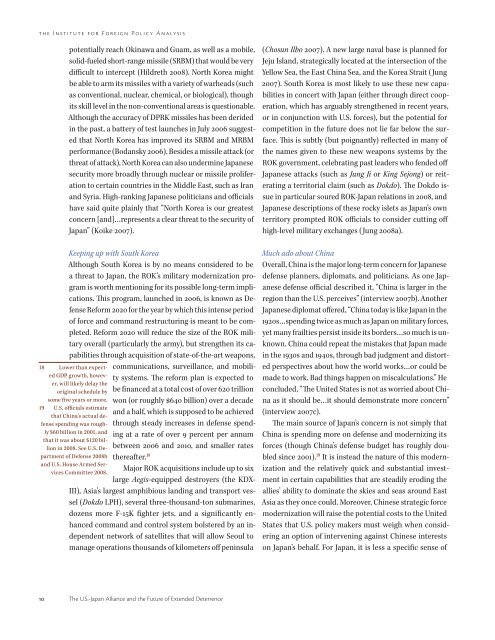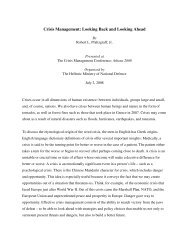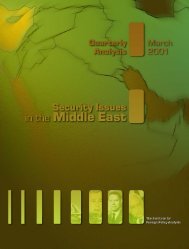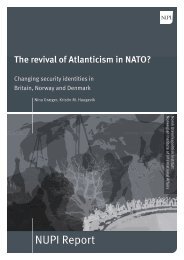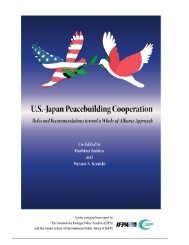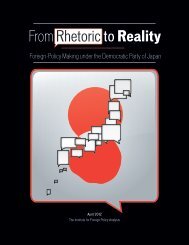Realigning Priorities: The U.S.-Japan Alliance and the Future of ...
Realigning Priorities: The U.S.-Japan Alliance and the Future of ...
Realigning Priorities: The U.S.-Japan Alliance and the Future of ...
Create successful ePaper yourself
Turn your PDF publications into a flip-book with our unique Google optimized e-Paper software.
t h e I n s t i t u t e f o r F o r e i g n P o l i c y A n a ly s i s<br />
potentially reach Okinawa <strong>and</strong> Guam, as well as a mobile,<br />
solid-fueled short-range missile (SRBM) that would be very<br />
difficult to intercept (Hildreth 2008). North Korea might<br />
be able to arm its missiles with a variety <strong>of</strong> warheads (such<br />
as conventional, nuclear, chemical, or biological), though<br />
its skill level in <strong>the</strong> non-conventional areas is questionable.<br />
Although <strong>the</strong> accuracy <strong>of</strong> DPRK missiles has been derided<br />
in <strong>the</strong> past, a battery <strong>of</strong> test launches in July 2006 suggested<br />
that North Korea has improved its SRBM <strong>and</strong> MRBM<br />
performance (Bodansky 2006). Besides a missile attack (or<br />
threat <strong>of</strong> attack), North Korea can also undermine <strong>Japan</strong>ese<br />
security more broadly through nuclear or missile proliferation<br />
to certain countries in <strong>the</strong> Middle East, such as Iran<br />
<strong>and</strong> Syria. High-ranking <strong>Japan</strong>ese politicians <strong>and</strong> <strong>of</strong>ficials<br />
have said quite plainly that “North Korea is our greatest<br />
concern [<strong>and</strong>]…represents a clear threat to <strong>the</strong> security <strong>of</strong><br />
<strong>Japan</strong>” (Koike 2007).<br />
Keeping up with South Korea<br />
Although South Korea is by no means considered to be<br />
a threat to <strong>Japan</strong>, <strong>the</strong> ROK’s military modernization program<br />
is worth mentioning for its possible long-term implications.<br />
This program, launched in 2006, is known as Defense<br />
Reform 2020 for <strong>the</strong> year by which this intense period<br />
<strong>of</strong> force <strong>and</strong> comm<strong>and</strong> restructuring is meant to be completed.<br />
Reform 2020 will reduce <strong>the</strong> size <strong>of</strong> <strong>the</strong> ROK military<br />
overall (particularly <strong>the</strong> army), but streng<strong>the</strong>n its capabilities<br />
through acquisition <strong>of</strong> state-<strong>of</strong>-<strong>the</strong>-art weapons,<br />
communications, surveillance, <strong>and</strong> mobility<br />
systems. <strong>The</strong> reform plan is expected to<br />
be financed at a total cost <strong>of</strong> over 620 trillion<br />
won (or roughly $640 billion) over a decade<br />
<strong>and</strong> a half, which is supposed to be achieved<br />
through steady increases in defense spending<br />
at a rate <strong>of</strong> over 9 percent per annum<br />
between 2006 <strong>and</strong> 2010, <strong>and</strong> smaller rates<br />
<strong>the</strong>reafter. 18<br />
Major ROK acquisitions include up to six<br />
large Aegis-equipped destroyers (<strong>the</strong> KDX-<br />
III), Asia’s largest amphibious l<strong>and</strong>ing <strong>and</strong> transport vessel<br />
(Dokdo LPH), several three-thous<strong>and</strong>-ton submarines,<br />
dozens more F-15K fighter jets, <strong>and</strong> a significantly enhanced<br />
comm<strong>and</strong> <strong>and</strong> control system bolstered by an independent<br />
network <strong>of</strong> satellites that will allow Seoul to<br />
manage operations thous<strong>and</strong>s <strong>of</strong> kilometers <strong>of</strong>f peninsula<br />
18 Lower than expected<br />
GDP growth, however,<br />
will likely delay <strong>the</strong><br />
original schedule by<br />
some five years or more.<br />
19 U.S. <strong>of</strong>ficials estimate<br />
that China’s actual defense<br />
spending was roughly<br />
$60 billion in 2001, <strong>and</strong><br />
that it was about $120 billion<br />
in 2008. See U.S. Department<br />
<strong>of</strong> Defense 2008b<br />
<strong>and</strong> U.S. House Armed Services<br />
Committee 2008.<br />
(Chosun Ilbo 2007). A new large naval base is planned for<br />
Jeju Isl<strong>and</strong>, strategically located at <strong>the</strong> intersection <strong>of</strong> <strong>the</strong><br />
Yellow Sea, <strong>the</strong> East China Sea, <strong>and</strong> <strong>the</strong> Korea Strait (Jung<br />
2007). South Korea is most likely to use <strong>the</strong>se new capabilities<br />
in concert with <strong>Japan</strong> (ei<strong>the</strong>r through direct cooperation,<br />
which has arguably streng<strong>the</strong>ned in recent years,<br />
or in conjunction with U.S. forces), but <strong>the</strong> potential for<br />
competition in <strong>the</strong> future does not lie far below <strong>the</strong> surface.<br />
This is subtly (but poignantly) reflected in many <strong>of</strong><br />
<strong>the</strong> names given to <strong>the</strong>se new weapons systems by <strong>the</strong><br />
ROK government, celebrating past leaders who fended <strong>of</strong>f<br />
<strong>Japan</strong>ese attacks (such as Jung Ji or King Sejong) or reiterating<br />
a territorial claim (such as Dokdo). <strong>The</strong> Dokdo issue<br />
in particular soured ROK-<strong>Japan</strong> relations in 2008, <strong>and</strong><br />
<strong>Japan</strong>ese descriptions <strong>of</strong> <strong>the</strong>se rocky islets as <strong>Japan</strong>’s own<br />
territory prompted ROK <strong>of</strong>ficials to consider cutting <strong>of</strong>f<br />
high-level military exchanges (Jung 2008a).<br />
Much ado about China<br />
Overall, China is <strong>the</strong> major long-term concern for <strong>Japan</strong>ese<br />
defense planners, diplomats, <strong>and</strong> politicians. As one <strong>Japan</strong>ese<br />
defense <strong>of</strong>ficial described it, “China is larger in <strong>the</strong><br />
region than <strong>the</strong> U.S. perceives” (interview 2007b). Ano<strong>the</strong>r<br />
<strong>Japan</strong>ese diplomat <strong>of</strong>fered, “China today is like <strong>Japan</strong> in <strong>the</strong><br />
1920s…spending twice as much as <strong>Japan</strong> on military forces,<br />
yet many frailties persist inside its borders…so much is unknown.<br />
China could repeat <strong>the</strong> mistakes that <strong>Japan</strong> made<br />
in <strong>the</strong> 1930s <strong>and</strong> 1940s, through bad judgment <strong>and</strong> distorted<br />
perspectives about how <strong>the</strong> world works…or could be<br />
made to work. Bad things happen on miscalculations.” He<br />
concluded, “<strong>The</strong> United States is not as worried about China<br />
as it should be…it should demonstrate more concern”<br />
(interview 2007c).<br />
<strong>The</strong> main source <strong>of</strong> <strong>Japan</strong>’s concern is not simply that<br />
China is spending more on defense <strong>and</strong> modernizing its<br />
forces (though China’s defense budget has roughly doubled<br />
since 2001). 19 It is instead <strong>the</strong> nature <strong>of</strong> this modernization<br />
<strong>and</strong> <strong>the</strong> relatively quick <strong>and</strong> substantial investment<br />
in certain capabilities that are steadily eroding <strong>the</strong><br />
allies’ ability to dominate <strong>the</strong> skies <strong>and</strong> seas around East<br />
Asia as <strong>the</strong>y once could. Moreover, Chinese strategic force<br />
modernization will raise <strong>the</strong> potential costs to <strong>the</strong> United<br />
States that U.S. policy makers must weigh when considering<br />
an option <strong>of</strong> intervening against Chinese interests<br />
on <strong>Japan</strong>’s behalf. For <strong>Japan</strong>, it is less a specific sense <strong>of</strong><br />
10<br />
<strong>The</strong> U.S.-<strong>Japan</strong> <strong>Alliance</strong> <strong>and</strong> <strong>the</strong> <strong>Future</strong> <strong>of</strong> Extended Deterrence


